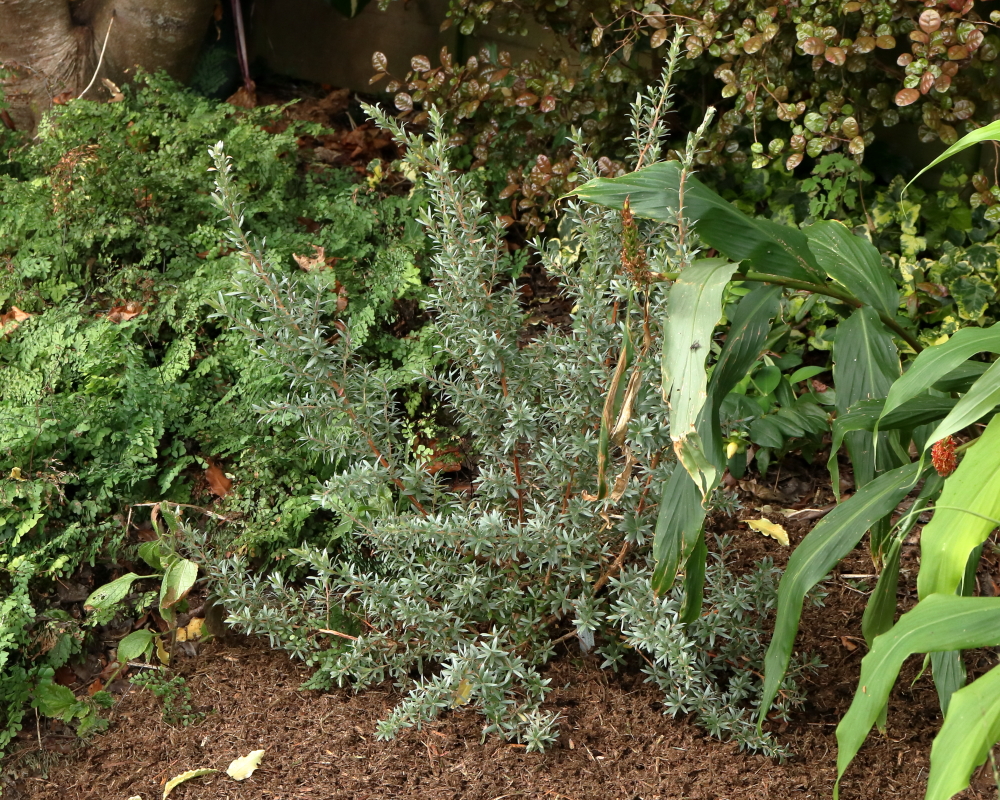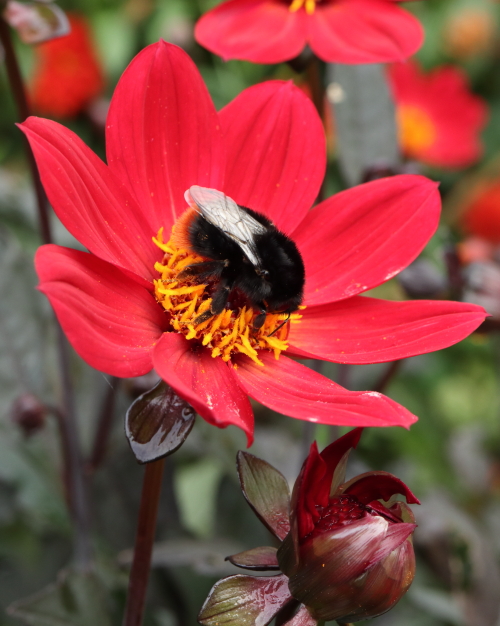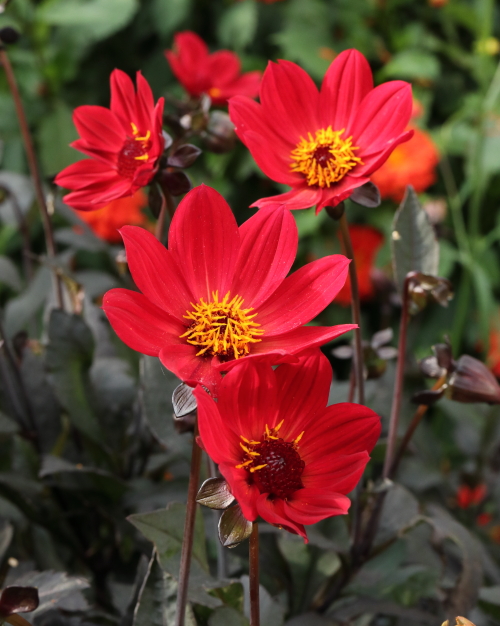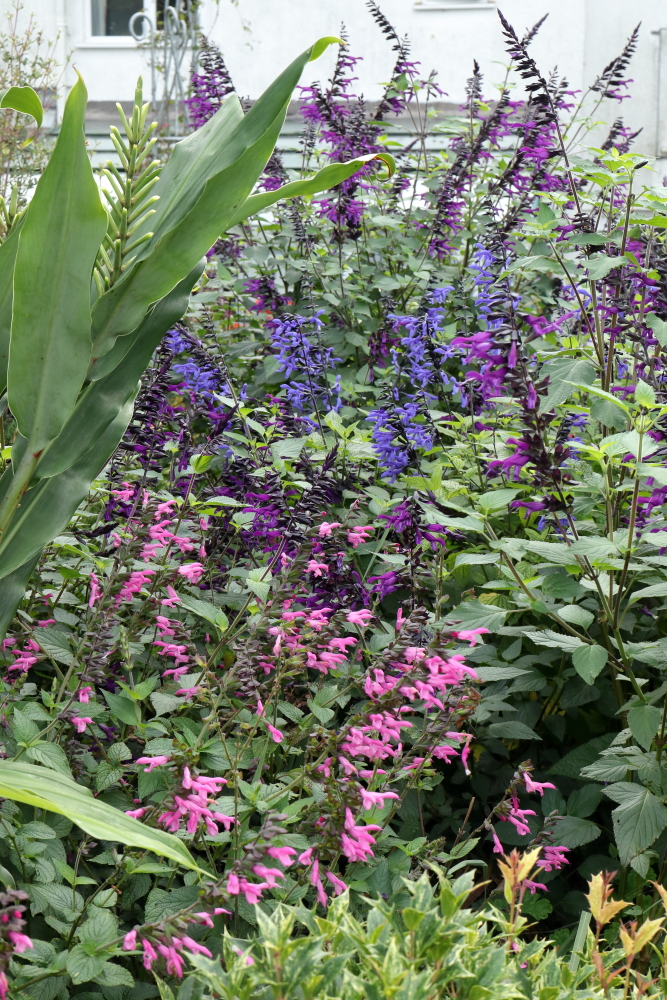I finally have my new computer up and running. It’s much the same but not the same, lots of little things are different, some of which can be changed to what I’m used to, some not. I might be getting too old to be swapping SSD’s from one computer to another then diving into disk management to allocate drive letters, to pick out just one of the things thrown up by the changeover.
Gardening is generally a bit more forgiving; you can get it almost right and it will still work. Things do still die though, and like computers you are all too often unsure what has gone wrong. I’m getting ahead of myself though; the intro bit goes like this: Six on Saturday – find six things happening in your garden, or a garden; take pictures and post them on a blog or social media channel. Stick a comment down below with a link to your post. Easy, let’s get on.
One.
Like I say, things die. Muehlenbeckia astonii has graced our back garden for a good few years. It came into leaf back in the spring but when June’s heatwave hit, it became very stressed and eventually, in spite of waterings, lost all its leaves. A few twigs greened up again in July’s rain but then they withered and died. I dug it out last weekend and replaced it with Leptospermum ‘Silver Sheen’, a plant we’d bought a couple of months earlier with no clear idea of where we were going to put it. We had a big bush of it out the front years ago but it got too big and had to go.
The root system of the Muehlenbeckia showed signs of honey fungus so either it was fighting that and the drought finished it off or vice versa.



Two.
Liriope muscari is a plant I’ve seen and admired in gardens and nurseries and I have long had two forms in the garden that I bought way back. Both are rubbish, one has pathetic thin pale flowers, the other just doesn’t flower. This one was given me as a small division off a plant in someone’s garden. I think this is now its second or third year and its modest flower display, three spikes, has certainly condemned one of the existing plants to oblivion. The non-flowerer I will move and give one last chance.
Three.
Salvias, of the guaranitica type. We planted several Salvias in this bed last year. Late in the year we took cuttings as insurance, leaving the parent plants in the ground. In spring this year we planted out the young plants, by then about a foot tall, in between last years plants, which at that stage were doing nothing. Through the early part of the year I battled slugs which were intent on stopping the older plants growing, then found myself watering daily for several weeks to keep all of them alive and hopefully get some growth going. There were a few flowers around in July and August but look at them now! Purple ‘Amistad’, pink ‘Amistad Pink’ and blue ‘Black and Bloom’. We bought, not in flower, a plant under the name ‘Carine’s Amazing Blue’; it is ‘Black and Bloom’.
Four.
Some things have a season of showing off; in flower or new growth typically. Some things just quietly get on with it, not seeking attention, and are rewarded by not getting any. I have several forms of Hakonechloa, I wonder if I’ve ever put this one in a Saturday six. It’s a paler green than the others, with white stripes, and is called ‘Stripe it Rich’. Back in nursery days, the liner supplier from whom we were getting young plants of it, dropped it because it was just too slow to produce a saleable plant. There are still nurseries offering it, presumably propagating it themselves, but not many. In the garden, being slow growing is a drawback to begin with, but in time becomes an asset. The fern, Paesia scaberula, seems to have moved through and around it without causing any problems.

Five.
At the other extreme are Dahlias, where subtlety is not the first thing that springs to mind. Dahlia ‘Happy Single Flame’ is one of my more recent acquisitions and has fiery flowers against black foliage. Like the Salvias, after a slow start my Dahlias are flowering freely now and would be better still if I was more on top of deadheading.


Six.
Sue is starting to think, and fret, about moving back into her glasshouse the succulents that she moved out in the spring. They’re not yet at risk from cold but a start needs to made on drying them out quite a lot for the winter. The trouble is, she moved them out in the spring then filled the space with new plants and potted on old ones. This happens every year. A way will be found.

Another one bites the dust. Till next week, au revoir.


Where is the post about figs and those you get two crops from each year Fred?
LikeLike
Wow, that salvia display is beautiful! The lime green of that Hakonechloa is also really nice — I keep on saying I’m going to start collecting grasses but can never figure out where to start because the little pots always look so underwhelming.
LikeLike
If you’ve an area of moist partial shade then Hakonechloa is very hard to beat. It’s worth holding out for a good potfull though, they can be a bit slow to get going.
LikeLike
It’s always challenging to get set up with a new computer, isn’t it? I’m about due to do the same. So many beautiful plants here. The Liriope and the Hakonechloa grass are really special. Great post, as always.
LikeLike
Good luck with your computing transition. I’m getting there but there’s always something that doesn’t want to work on the new one.
LikeLike
There seem to be a few dilemmas in your post today – and some jolly nice salvias too (not that Amistad has ever been nice for me so I have never felt it worth trying those others, sadly) No joy for me with Liriope either… My mostly tall six are here: https://ramblinginthegarden.wordpress.com/2023/09/16/six-on-saturday-i-am-not-heightist-but/
ps could you give us the lowdown on success with growing cleome from seed please….?
LikeLike
The freshly harvested Cleome seed I sowed 28th August has germinated well enough, though not very evenly; it looks like they’ll be popping up for some while yet, making pricking off tricky. I don’t do anything special with them and get very mixed results, from nothing at all through to good, which suggests it’s to do with the quality of the seed. My worst results have been with bought seed, which has often not germinated at all.
LikeLike
So, still pot luck, but fresh seed is critical 👍 You don’t stratify yours? And you autumn sow?
LikeLike
I did a small autumn sowing this year, experimentally, for the first time. They are germinating well enough but a slug has already found them. It is no longer with us. I haven’t stratified spring sown seeds. I have been told that they benefit from variable temperatures to germinate and I think I kept them at an unheated ambient temperature, which would have been on my bedroom floor, so not very variable. Not very warm either.
LikeLike
Haha, thanks for all the info, Jim – at least it confirms it is not really my fault that I have had no success with them… 😉
LikeLiked by 1 person
Those Salvias – WOW! They are fabulous. I need to try them again (they didn’t survive from last year, for some reason). And I feel for Sue, if there is space it is so easy to fill it!
Here’s my six: https://mominthegarden.com/2023/09/16/arrangements-from-the-garden/
LikeLiked by 1 person
Happy Saturday, Jim, I’m grateful that you figured out your new computer enough to still host SoS this week. The trouble is, the technology gets exponentially more complex with each generation rather than simpler. I admire you for getting on with it. Your Salvias make a stunning display. I nod and grin reading your description of how you had to coddle them all summer, but it paid off at last. I love how your fern has woven itself through your H. ‘Stripe it Rich.’ Lovely. Good luck to you and Sue finding a place for all of your tender treasures. There is always a way, but things may be a bit jumbled indoors- at least that is usually the case for us.
Here are my six for the week: https://woodlandgnome.wordpress.com/2023/09/16/six-on-saturday-to-those-who-wait/
LikeLiked by 1 person
Of the guaranitica-type Salvias, ‘Amistad’ is definitely my favorite. The purple flowers look so good with the dark bracts and stems. Unfortunately, it isn’t as vigorous in my garden as the old ‘Black-and-Blue’. A local nursery is offering a new hybrid called ‘Jean’s Jewel’ which basically looks like a taller ‘Amistad’ with green stems. I think I might give it a try.
Here are my six: some garden plants, a greenhouse plant, and a couple of garden animals.
LikeLiked by 1 person
As much as I like the flowers of ‘Amistad’, the blue of ‘Black and Bloom’ (and I must pin down the difference between it and ‘Black and Blue’, if their is any) stands out very much better in the garden. ‘Amistad’ would perhaps benefit from a contrasting colour behind or among it.
LikeLiked by 1 person
My understanding, which could be wrong, is that ‘Black and Blue’ is a cultivar of Salvia guaranitica, while ‘Amistad’ is a hybrid, perhaps S. guaranitica x S. gesneriiflora
LikeLiked by 1 person
Well, my Black and Bloom expired in August. I enjoyed seeing yours! The computer business is so tiresome and I wish it would stay the same, but it won’t. I realized recently I had an account with a liriope grower, and the newer varieties are really something. https://theshrubqueen.com/2023/09/16/six-on-saturday-september-stars/
LikeLiked by 1 person
Having an account with a Liriope grower sounds improbably niche. Come to that, being a Liriope grower sounds improbably niche. I’ve seen nothing over here of new varieties of Liriope but will keep my eyes open.
LikeLiked by 1 person
It is actually a groundcover grower, they started with liriope and expanded to other things. Still kind of niche. Liriope is very popular in the southeastern US.
LikeLiked by 1 person
So true – things die! When I began gardening, I was blessed with a book called Organic Gardening West of the Cascades, and initially only grew things known to thrive. I needed success, not a challenge. Now I have more confidence and am more willing to try things that might not work out. I am still trying to understand what chinese long bean want. Mine grow, flower, and make beans but not very many beans. Maybe one needs to give them more room. and plant more seed. Anyway, things are winding down, but the purple and gold of the fall asters and goldenrod are on display. Love the red dahlias! Nice pop of color and I prefer the simple ones because a flower without a bee is sad to see! Here are my six:
LikeLiked by 2 people
When new people turn up on our allotment site and look like they’re new to gardening (it’s the shiny, new, but cheap tools that gives it away) I always want to tell them to get some easy successes under their belts before taking on the tricky stuff. Disappointment is easier to take when you’ve got some successes under your belt. Do they want advice from me? Of course not! Would I, if the situation was reversed, nope! I don’t know what Chinese long beans want either but you have me thinking maybe I should try to find out.
LikeLike
I enjoy the salvias. I have a guaranitica type “Black and Blue”. It seems so soon after the summer heat that I have to think of overwintering tender plants.
Here is my effort for the week.
Happy gardening!
LikeLike
So much stuff here is actively growing, having had something of a shutdown in June. It won’t help their frost hardiness, especially if we get cold weather early in the winter, which we did last year.
LikeLike
We are having the succulent conversation but about three really quite big ensete marellii that are yellowing and will need to go under cover soon. Overwintering one in the small greenhouse was fine. Overwintering three in the same space, not so fine.
LikeLiked by 1 person
I thought I’d get away with one of those in my unheated poly tunnel last year – wrong! Overwintering a small one was fine but it grew. It can get harsh when choosing which plants get the favoured heated space and which have to take their chances in the cold.
LikeLike
Sue’s succulents are looking in tip top condition, it is an extensive collection, good job there is such a good glass house, but I am sure it will be hard to get them all back in. Here are my six: https://noellemace.blogspot.com/2023/09/six-on-saturday-soggy-saturday.html
LikeLiked by 2 people
She popped out to meet someone this morning and came back with two more plants. Incorrigible.
LikeLike
I forgot to add our link… https://jenanita01.com/2023/09/16/six-on-saturday-bonsai-style/
LikeLiked by 1 person
Autumn is almost here, time to be thinking of the garden closing down. Well, most of it anyway…
LikeLiked by 1 person
My liriope is a real disappointment, I am jealous of yours, I think in the UK it can be quite miffy. Love those salvias! Here are my 6 (plus…) https://notesfromtheundergardener.wordpress.com/2023/09/16/six-on-saturday-16th-september-2023/. Happy weekend everyone!
LikeLiked by 1 person
It’s so hard to know why plants underperform, poor variety, planted in the wrong place, under attack by vine weevil grubs, all of these?
LikeLiked by 1 person
Probably all of these and more!
LikeLiked by 1 person
Greenhouses – they are never big enough are they? and who could be so cruel as to cull ones plants? They must all be kept and tended. I feel Sue’s predicament. My predicament is year is the purchase of pelargoniums which won’t overwinter in an unheated greenhouse and need to be brought indoors, but are currently sitting in big terracotta pots so will need reducing in size first. I want to enjoy them outside for as long as possible though.
Anyway, back to this week’s six
https://www.hortusbaileyana.co.uk/2023/09/the-last-days-of-summer.html
LikeLiked by 1 person
We have a few Pelargoniums but they stay in the greenhouse all year, the north facing one at the back of the house where cold and lack of sun take their toll of them every winter.
LikeLiked by 1 person
I asked a question this morning about the Muehlenbeckia in your September Garden video and you’ve answered it here. I’m a gardening quilter today so will be back later to see the other posts.
LikeLiked by 1 person
Reading about your Liriope makes me think that mine might benefit from being in more light, it is in the woodland now and hardly ever flowers, I’ll have to think about moving it. Salvias are spectacular, such a lovely display!
My six are here…….https://www.leadupthegardenpath.com/
LikeLiked by 2 people
I’m in awe of your salvias. They don’t overwinter here so I don’t grow them. Perhaps I should be wise and take the cuttings route. I can empathise with Sue, many times my greenhouse has been cleared and sat empty until I felt I had to fill it with pretty plants, only to find it full when I really needed it. Love that Dahlia!
Here’s mine for this week:
LikeLiked by 1 person
I’m finding that plants will come through the winter but get browsed off at ground level by small slugs as they try to get going in spring, such that there is nothing to see and it’s easy to conclude they’ve died. Get over that hurdle and the plants left in the ground do better than new plantings – on an established root system presumably.
LikeLike
Yes, an established plant is the best if it can be achieved. Last year I dug up and potted on all my verbena ‘Santos Purple’ and overwintered them in the cold frame. This year they’ve been bigger & stronger plants – but realistically I can’t do that with everything. But what you’re saying is to keep an eye out for early new growth and don’t assume they’ve died, then protect from little slugs. I must keep that in mind!
LikeLiked by 1 person
I love your salvia display, very impressive! Once they get going there is no stopping them. Your new leptospermum looks very interesting, you must have subconsciously known that a space was about to come free. Or maybe not. Here are mine, I’ve been having a tech nightmare this week too https://offtheedgegardening.com/2023/09/16/six-on-saturday-new-phone/
LikeLiked by 2 people
I don’t know about subconsciously, I just know that a space will come free either when something dies or I decide to kill it. ‘Silver Sheen’ was quite a good seller around 20 years ago but you don’t see it much now.
LikeLike
That combination of Salvias looks wonderful. I’m gradually adding a few more to the garden, although I’m always surprised how big the shrubby lot get. I hope the succulent move goes okay https://onemanandhisgardentrowel.wordpress.com/2023/09/16/six-on-saturday-16-september-2023/
LikeLiked by 1 person
Lovely salvias. I’m missing this week as 1) it was very windy today and 2) nothing much new to report. Hope to be back next week!
LikeLiked by 2 people
I was looking at the weather forecast and the freshness and the humidity are back… Sue is right and I will soon bring some plants into the greenhouse too. This week I like the liriope muscari that you showed as well as of course the group of salvias! https://fredgardenerblog2.wordpress.com/2023/09/16/six-on-saturday-16-09-23/
LikeLiked by 1 person
The allure of Liriope muscari escapes me. I know it looks prettier in the Pacific Northwest, but it is not the same here. It is vigorous enough to be almost invasive, but is not pretty enough to justify contending with such potential invasiveness. I only grow it because it is so reliable, and displaces weeds, which would be worse. The original was variegated, but the bit that reverted to simple green dominated. I separated a bit of the variegated form out, just in case I want to grow it later. Yours is certainly more impressive.
Various cultivars of Leptospermum are popular here because they are right at home within the climate. Some are small trees. Some can be shorn as hedges. Once they settle in, they are very undemanding.
What is that yellowish specimen in the last picture that seems to be a Yucca? Is it a Furcraea?
Here are my six, which are only two species, with the best for last.
LikeLiked by 2 people
Just once or twice I have seen Liriope putting on a really good flower display, enough allure to have worked on me at the time. That it might do so in dry shade, late in the year, while serving as an effective ground cover, is the fantasy I’m clinging to. I’m glad you asked about the yellow thing, it prompted me to look up its name, which is a long standing but unfulfilled good intention. Yucca recurvifolia ‘Banana Split’ is the answer. I know next to nothing about it, it has taken up greenhouse space in winter for the last decade and grown excruciatingly slowly into what is now quite a showy plant, if you like that sort of thing.
LikeLiked by 1 person
Oh, I should have remembered that distinctive name. You mentioned it quite a while ago.
LikeLiked by 1 person